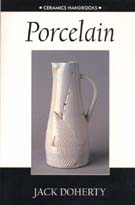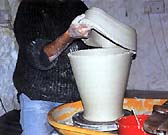| Jack Doherty - Porcelain
Review by Steven Goldate
 Jack
Doherty's Porcelain is another in the 'Ceramics Handbooks'
series by A&C Black (Published in the USA by the University
of Pennsylvania Press). It's a neat introduction to the topic for
the student, hobby artist or budding studio potter. Jack
Doherty's Porcelain is another in the 'Ceramics Handbooks'
series by A&C Black (Published in the USA by the University
of Pennsylvania Press). It's a neat introduction to the topic for
the student, hobby artist or budding studio potter.
Doherty introduces us to the material via its origins in China's
Tang dynasty (618-906 AD) and its peak during the Sung Dynasty (960-1279
AD), the spread to Europe and the subsequent 'porcelain craze' of
the 17th century. This is followed by the development of European
porcelain and its triumphant march through 18th century Europe.
After dealing with porcelain's general history, Doherty turns his
attention to the development of studio porcelain. Beginning with
Bernard Leach and his 'Sung Standard', he traces the rise of porcelain
as a preferred material for many accomplished studio potters - Lucie
Rie, David Leach, Geoffrey Whiting, Harry Davis, Mary Rogers, Rudi
Staffel and many others.
This concludes the historical section, and the author now delves
into technical side, covering materials, bodies, forming processes,
decoration types, firing methods and glazes.
 While
at first it may appear strange to mix historical fact with technical
know-how, the idea begins to make sense when we look at the target
audience of the 'Ceramics Handbooks' range, as stated on the back
cover: "The books are aimed at the student or practiced ceramist
who is experimenting in a new area". I would also add to this
list 'the serious hobby potter'. In that respect, it makes sense
to introduce the topic with some history and analysis of modern
work, providing inspiration to develop something interesting with
the new material. While
at first it may appear strange to mix historical fact with technical
know-how, the idea begins to make sense when we look at the target
audience of the 'Ceramics Handbooks' range, as stated on the back
cover: "The books are aimed at the student or practiced ceramist
who is experimenting in a new area". I would also add to this
list 'the serious hobby potter'. In that respect, it makes sense
to introduce the topic with some history and analysis of modern
work, providing inspiration to develop something interesting with
the new material.
The following chapters provide some of the necessary technical
knowledge to work with a difficult body.
- Materials: a brief chapter outlining the base materials which
most porcelain bodies are formulated from.
- Porcelain Bodies: Provides a description of commercial manufacturing
processes and how to make your own porcelain in the studio. This
chapter includes hints on how to achieve the various properties
you are looking for in a porcelain body - translucency, whiteness,
vitrification, etc., while at the same time retaining plasticity.
- Forming Methods: covers wheel-throwing, hand-building, slip-casting,
joining, altering, composite forms and tools.
- Decoration: looks at how to decorate leather-hard porcelain,
how to add color, apply slips and how to paint on porcelain.
- Firing Processes: explains the full range of firing techniques
suitable for porcelain, ranging from once-firing to oxidation
in an electric kiln, reduction firing in a wood-firing kiln and
even salt and soda-glazing. All of these approaches are valid
and can yield great results.
- Glaze: this chapter concludes the technical section. A number
of glaze recipes are offered, which are suitable for the various
possible firing scenarios. Also includes some helpful notes on
glaze application.
 The
final chapter 'Contemporary Approaches' offers a modern perspective
and another opportunity to be inspired by what present-day ceramists
are doing with the material. Julian Stair (UK), Janet De Boos (Australia),
Ryoji Koie (Japan) and Pieter Stockmans (Netherlands) are a few
of those mentioned that display a sensibility appropriate to the
medium. The
final chapter 'Contemporary Approaches' offers a modern perspective
and another opportunity to be inspired by what present-day ceramists
are doing with the material. Julian Stair (UK), Janet De Boos (Australia),
Ryoji Koie (Japan) and Pieter Stockmans (Netherlands) are a few
of those mentioned that display a sensibility appropriate to the
medium.
More book reviews
|